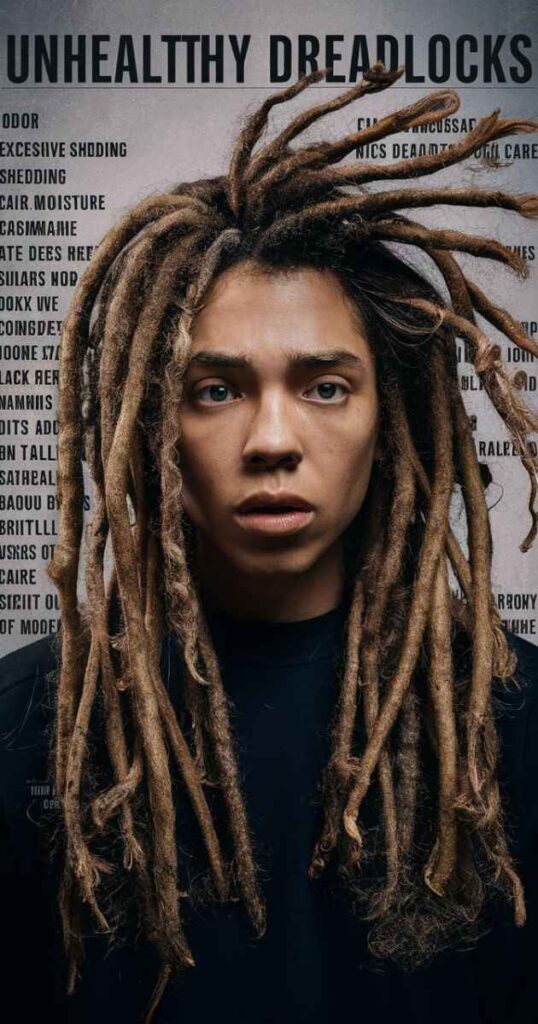Dreadlocks are a hairstyle characterized by rope-like strands of hair. They form through a process of matting and locking hair together. Dreadlocks can be created with various hair types and textures. This style has cultural significance in many communities worldwide.
Are your dreadlocks looking dull, weak, or damaged? “Signs of Unhealthy Locs: Tips for Dreadlocks Care & Repair” is your guide to reviving your locks. Learn how to identify problems and restore your dreadlocks to their former glory. Discover essential maintenance techniques for healthy, vibrant locs.
Dreadlocks require proper care and attention to maintain their appearance and health. Regular washing, moisturizing, and maintenance are crucial. Without proper care, locs can become dry, brittle, or prone to breakage. Understanding the signs of unhealthy dreadlocks is key to preventing damage and promoting growth.
Healthy Dreads vs Unhealthy Dreadlocks:
| Healthy Dreads | Unhealthy Dreadlocks |
| Moisturized and soft | Dry and brittle |
| Strong and intact | Weak and prone to breakage |
| Fresh, clean scent | Musty or unpleasant odor |
| Even thickness | Thinning or uneven spots |
| Shiny appearance | Dull or lifeless look |
| Scalp is clean and itch-free | Itchy scalp with visible buildup |
| Minimal frizz | Excessive frizz or loosening |
| Flexible and bouncy | Stiff and inflexible |
| Grows consistently | Slow or stunted growth |
| Easily maintained | Difficult to manage |
5 Healthy Locs Signs:

Every head of locs is unique. What’s normal for one person may not be for another. Pay attention to changes in your locs. If you notice anything unusual, consult a loctician. They can help you maintain the health of your dreadlocks.
1. Neat and clean
Healthy dreadlocks should look tidy and clean. Regular washing is key to maintaining this appearance. Use a residue-free shampoo to cleanse your locs. Aim to wash your hair every 1-2 weeks. This helps prevent buildup of dirt and oils.
Clean locs have a fresh scent. They shouldn’t have any musty or unpleasant odors. After washing, make sure to dry your locs thoroughly. This prevents mold growth inside the locs.
Neat locs have a uniform appearance. They should be free from loose hairs sticking out. Regular maintenance helps keep your locs looking neat and tidy.
2. Well-moisturized
Healthy locs are well-moisturized. They should feel soft to the touch, not dry or brittle. Moisturized locs have a natural shine. They don’t look dull or lifeless.
Use a light oil or moisturizer on your locs regularly. This helps keep them hydrated. Avoid heavy products that can cause buildup. Water-based moisturizers work well for most people.
Well-moisturized locs are less prone to breakage. They maintain their strength and flexibility. This is crucial for the long-term health of your dreadlocks.
3. No breakage
Healthy locs shouldn’t show signs of breakage. Look for split ends or locs that are thinning at the roots. These are signs of unhealthy locs.
Avoid tight hairstyles that put stress on your locs. This can lead to breakage over time. Be gentle when styling or maintaining your locs.
If you notice breakage, address it promptly. You may need to adjust your care routine. Sometimes, professional help is needed to repair damaged locs.
4. Consistent growth
Healthy locs show consistent growth. You should notice your locs getting longer over time. The rate of growth varies from person to person. But it should be steady.
Measure your locs periodically to track growth. This can help you spot any issues early. Slow or stalled growth might indicate a problem with your locs or scalp health.
A healthy diet and scalp care promote consistent growth. Make sure you’re getting enough nutrients for healthy hair growth.
5. Size and shape
Healthy locs maintain a consistent size and shape. They shouldn’t be thinning or getting unusually thick in spots. The size of your locs should be relatively uniform from root to tip.
The shape of your locs should be cylindrical. They shouldn’t be flat or have irregular bumps. Misshapen locs can be a sign of improper maintenance or health issues.
Regular retwisting or palm rolling helps maintain the shape of your locs. This is an important part of dreadlock maintenance. It keeps your locs looking neat and uniform.
6 Signs of Unhealthy Locs:

Healthy locs require consistent care. Pay attention to these signs and address issues promptly. With proper maintenance, your dreadlocks can remain beautiful and healthy for years to come.
1. Scalp irritation
Scalp irritation is a common issue for people with dreadlocks. It can cause discomfort and lead to other problems. Itching, redness, and flaking are signs of an irritated scalp. This may be due to product buildup or infrequent washing.
To address this, try washing your locs more often. Use a gentle, residue-free shampoo. Avoid applying products directly to your scalp. Instead, focus on the length of your locs. Regular scalp massages can also help improve circulation and reduce irritation.
If the problem persists, consult a dermatologist. They can identify any underlying conditions and suggest treatments.
2. Excessive hair loss
Some hair shedding is normal, even with dreadlocks. However, excessive hair loss can be a sign of unhealthy locs. You might notice more hair than usual in your shower drain. Or you may see thinning areas in your locs.
Several factors can cause this issue. Tight hairstyles, harsh chemicals, and poor nutrition are common culprits. Stress and certain medical conditions can also lead to hair loss.
To combat this, be gentle when styling your locs. Avoid tight updos that put strain on your roots. Eat a balanced diet rich in vitamins and minerals. Consider taking biotin supplements to promote hair growth.
3. Foul smell
Healthy locs shouldn’t have an unpleasant odor. If your dreadlocks smell bad, it’s a sign of poor hygiene. This can happen when locs aren’t dried properly after washing. Mold and mildew can grow inside damp locs.
To prevent this, make sure your locs dry completely after washing. Use a hair dryer on low heat if needed. Wash your locs regularly with a clarifying shampoo. This will remove buildup and prevent odor-causing bacteria.
Some people use essential oils to keep their locs smelling fresh. Tea tree oil, in particular, has antibacterial properties. It can help combat odor and promote a healthy scalp.
4. Receding hairline
A receding hairline can be distressing for anyone with locs. It’s often caused by tension from tight hairstyles. This condition is called traction alopecia. It happens when constant pulling damages hair follicles.
To prevent this, avoid styles that pull on your edges. Give your hairline a break from tight updos. Use gentle products designed for loc maintenance. Massaging your scalp can stimulate blood flow and encourage hair growth.
If you notice thinning edges, act quickly. The sooner you address the issue, the better your chances of regrowth. In severe cases, you may need to consult a trichologist or dermatologist.
5. Scalp infection
Scalp infections can be serious if left untreated. They can cause pain, itching, and even hair loss. Common signs include redness, swelling, and pus-filled bumps. You might also experience fever or swollen lymph nodes.
Poor hygiene is a major cause of scalp infections. Washing your locs regularly is crucial. Use an antimicrobial shampoo to keep your scalp clean. Avoid sharing hair tools or accessories with others.
If you suspect an infection, see a doctor immediately. They can prescribe antibiotics or antifungal treatments. Don’t try to treat a scalp infection on your own.
6. Heavy locs
Locs that feel unusually heavy can indicate problems. This extra weight often comes from product buildup or improper maintenance. Heavy locs can cause headaches and neck pain. They may also lead to traction alopecia.
To lighten your locs, start with a deep cleanse. Use a clarifying shampoo to remove buildup. You might need to repeat this process several times. Consider having your locs professionally maintained.
In the future, use products sparingly. Focus on the length of your locs rather than the roots. Regular maintenance will prevent your locs from becoming too heavy.
How to Repair Unhealthy Locs?

Is your hair feeling dry and brittle? Don’t worry, there’s hope for your locs. Start by deep cleaning to remove buildup. Use a clarifying shampoo to wash your scalp and locs thoroughly. After cleaning, focus on moisture. Apply a nourishing oil or leave-in conditioner. Pay extra attention to your ends.
For severely damaged locs, consider professional help. A loctician can repair or even rebuild troubled areas. At home, try wrapping thin locs together to strengthen them. For frizzy locs, palm rolling can help smooth them out.
Pro Tips:
Remember, patience is key. Repairing locs takes time, but with consistent care, you’ll see improvement.
- Moisturize regularly to prevent dryness.
- Protect your locs while sleeping with a satin cap.
- Avoid tight hairstyles that stress your roots.
- Trim your locs occasionally to remove dead ends.
- Stay hydrated and eat a balanced diet for healthy hair growth.
FAQs:
How do you know if your dreads are unhealthy?
Look for signs like excessive dryness, thinning, breakage, or a musty smell. Unhealthy locs may also feel brittle or look dull.
How can I make my locs healthier?
Keep them clean, moisturized, and protected. Regular maintenance, a balanced diet, and proper hydration can greatly improve loc health.
What causes weak locs?
Overwashing, harsh chemicals, poor maintenance, and neglect can weaken locs. Stress and poor nutrition may also contribute to weak locs.
What damages locs?
Excessive manipulation, tight styling, using the wrong products, and infrequent maintenance can damage locs. Environmental factors like hard water can also cause harm.

